Byrds - Turn Turn Turn MONO |
|
Description & Collectors Information: The Mono edition of "Turn! Turn! Turn!" is an iconic piece of music history. The album features 12 tracks, including the title track, which was a cover of a Pete Seeger song. The album was produced by Terry Melcher and released on the Columbia label in 1965. The Mono edition of the album is highly sought after by collectors and music enthusiasts. The Mono version of the album is different from the stereo version in that it has a more raw and authentic sound. The Mono edition has a single channel of audio, which gives it a more unified and coherent sound. The stereo version, on the other hand, has two channels of audio, which can make it sound more artificial and processed. The album cover art features a photograph of the band , with a bright blue sky in the background. The image is symbolic of the optimism and hope that the album's music represents. The back cover features song titles and credits, along with liner notes written by the influential music journalist, Ralph J. Gleason. The album's title track, "Turn! Turn! Turn!" is one of the most recognizable songs in rock history. The lyrics, taken from the "Book of Ecclesiastes"", are a message of hope and peace. The song's melody and harmonies are beautifully crafted, and the guitar work is outstanding.
Rare Mono Edition Columbia 360 Sound
|
|
Music Genre: 60s American Rock |
|
Album Production Information: The album: "Byrds Turn Turn Turn" was produced by: Terry MelcherAlbum liner notes by Derek Taylor |
|
Record Label & Catalognr: Red Columbia CL 2454 / Non-breakable XLP 112089/90, Dual Walking Eye |
|
Media Format: 12" Vinyl Stereo Full-Length Long-Play Gramophone RecordAlbum weight: 280 gram |
|
Year & Country: 1965 Made in USA |
|
Transcript of the Liner notes of the album "Turn Turn Turn" by The Byrdss Well, here it is. And about time, too. Didn't our old grannies wag their wise and withered heads and tell us that good things are worth waiting for? This album was as long in the making as a President. But, as Jim McGuinn trusted it would, everything's worked out all right. Personally, I think it's a beautiful piece of work, and maybe The Byrds were right to linger over it. After all, a great record album is to the 1960's what a piece of sculpture was to the Middle Ages. Isn't it? The Byrds think it should be, and I agree with them because I agree with them on most things. So do The Beatles, by the way. They're Byrd-watchers. Two of the Fab Four came to the recording sessions at Columbia's Hollywood studios when they could have been sprawling beside their Bel Air pool gazing at Joan Baez. Some choice. Anyway, down from the hills rode George and Paul because they'd liked The Byrds' "Mr. Tambourine Man," and they know that a record like that doesn't happen by accident. ("Ho," John had said, "The Byrds have something," and the others had nodded.) So there they were, at Columbia—bachelor Beatle two-some, denims and fringes and so much experience, heads bent to pick up the sound-subtleties of the Los Angeles Byrds, whom The Beatles publicly named as their fab gear fave rave American group. Well, that was one glamorous night. Much of the time it was bark and bite, struggle and retape, battle and reshape, experiment and reject. "Just once more," said famed producer Terry Melcher a thousand times. And with so many once-mores and The •Byrds' creativity and a capful of other ingredients, we now have this most splendid album. Why is it so good? Mainly because The Byrds are so good. The great quality common to all The Byrds is that they really care about their music. I don't want to be boring about this—though they will bend your ears for hours on this subject—but the point is worth making because it is this prolonged, exact attention to detail and this involvement with the very best way to make music work for you that set The Byrds ahead, above, beyond and totally out of reach of their competitors. The Byrds, you see, are not prepared to be impris-oned by their music. They know that if material is good, it can be molded and fashioned at will. Any material. Any music. They proved this in their first album when they took a sentimental British keep-your-chin-up-and-your-upper-lip-stiff war song ("We'll Meet Again") and by investing it with a beautiful blend of barely discernible humor and Byrd harmony, produced a wonderfully fresh interpretation. And tasteful, too, for The Byrds are nothing if not aesthetic. Similarly , in this new album, they reach back to Stephen Foster for a song. They pluck out Oh! Susan-nah and make it, suddenly, pure Byrd. Again they add a touch of humor. Faint, but just enough. The Byrds rarely overdo anything. The constant artistic conflicts within the group—the striving for a thoroughly argued compromise—ensure that their songs are influenced by the best qualities of each of them. In other words, there is little chance that a song will be recorded without a dozen fistfights and great mouthfuls of awful abuse. For though McGuinn is leader, each member of his flock is an adroit, indi-vidual musician. This album is eclectic. (No, not electric. Eclectic. Look it up in Webster's.) Anyone ungenerous enough to suggest The Byrds rely on Dylan—and, surprisingly, there are one or two mean people in show business—will be disappointed to see that of the eleven numbers within this gorgeous sleeve, six are by Byrd-members, one is by Pete Seeger, one by S. Foster, another is an old country standard. Only two are by Dylan. What else is there to say? The Byrds came out of 1965 very well, their dignity unimpaired. They are admirable people, and I never tire of their musical music. They have their disciples all over the world, and the sky around them is heavy and resonant with the predatory wings of imitators. The Byrds merely wince slightly and smile within themselves. Folk-rock came and went this year, and the mor-tality rate was high. Protest growled briefly and died in great, wheezing gasps. The Byrds, unfettered, looked the other way and sang love songs. 1965, too, brought Hair music and no-room-at-the-inn music. That, too, grew inwards and suffocated it-self. The Byrds whistled Oh! Susannah and flew away on their motorcycles—away. away into the night over the Hollywood hills. Enjoy this lovely album, and give it to grumpy uncles for Christmas. It will help. |
Band Members and Musicians on: Byrds Turn Turn Turn MONO |
|
Complete Track Listing of: "Byrds Turn Turn Turn" |
|
The Songs/tracks on "Byrds Turn Turn Turn" are
|
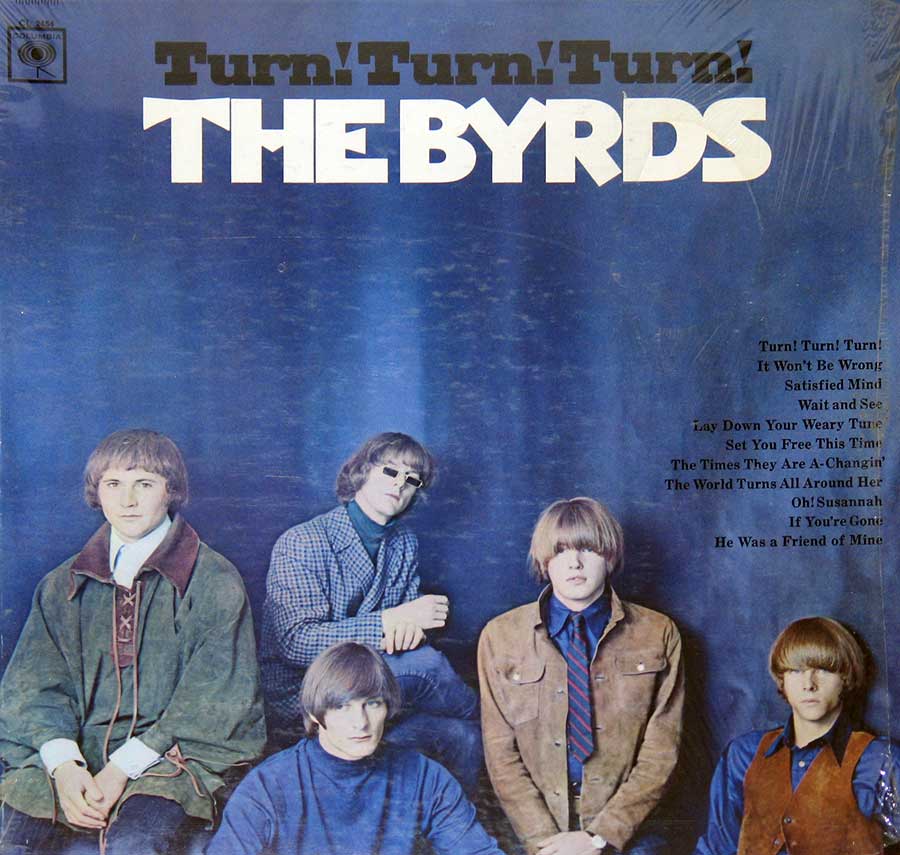
Note: The photos on this page are taken from albums in my personal collection. Slight differences in color may exist due to the use of the camera's flash. Images can be zoomed in/out ( eg pinch with your fingers on a tablet or smartphone ).
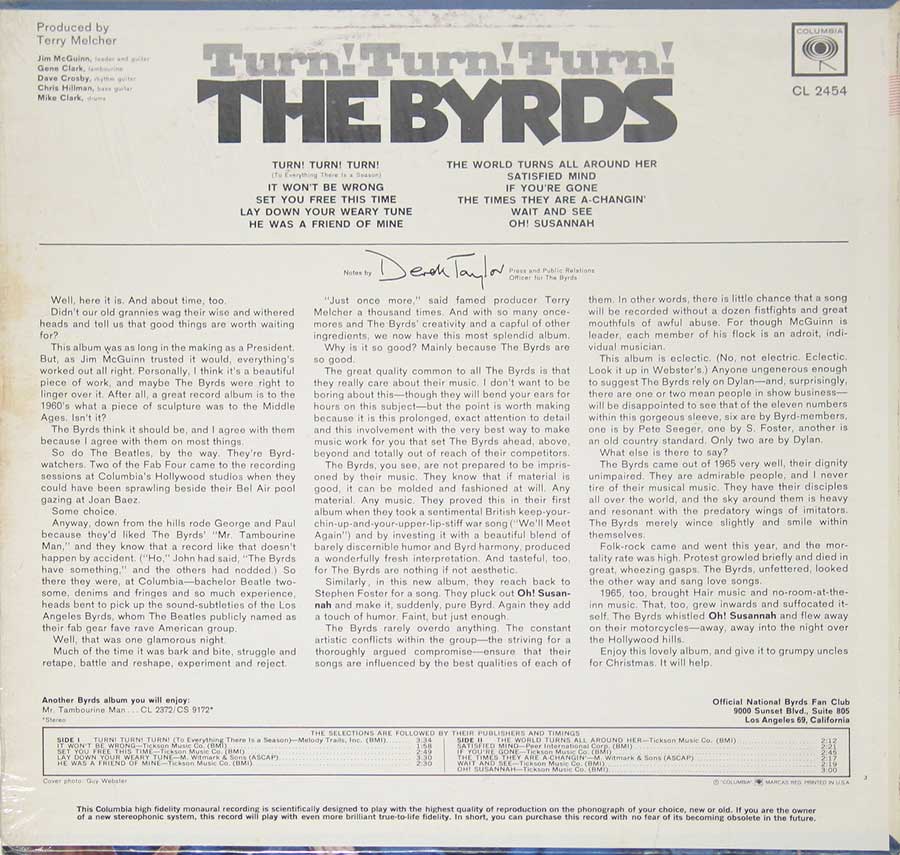
"Turn Turn Turn by the Birds" Red Colour with two Walking Eye Logo's Columbua Record Label Details: CL 2454 Non-Breakable, Printed in U.S.A.
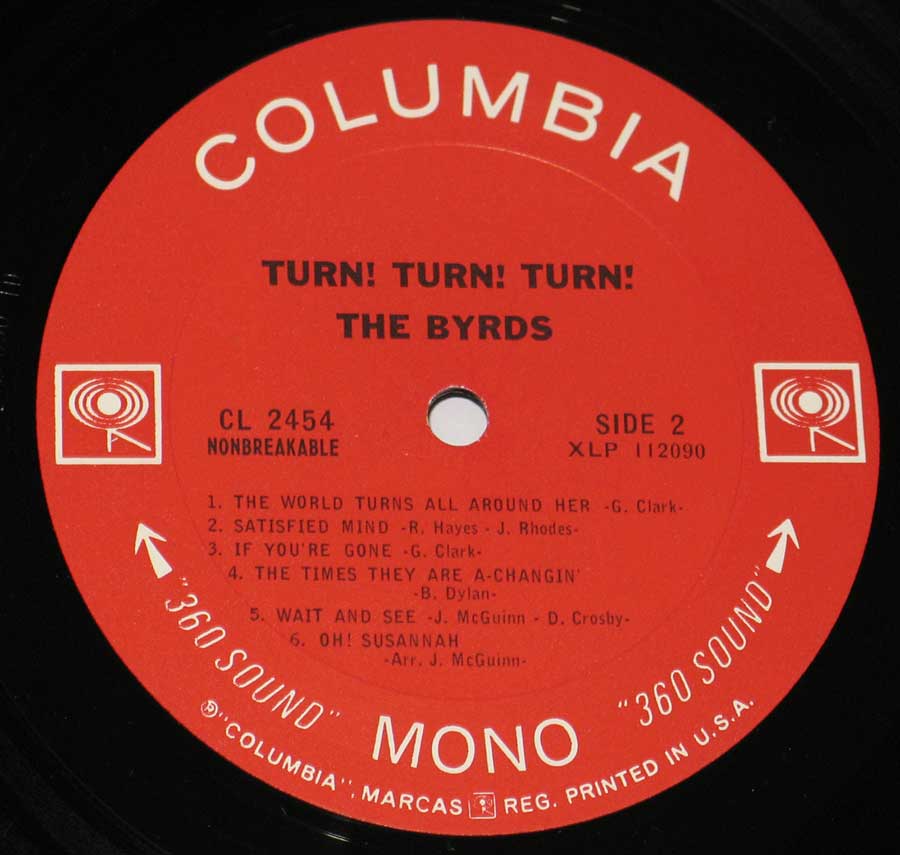
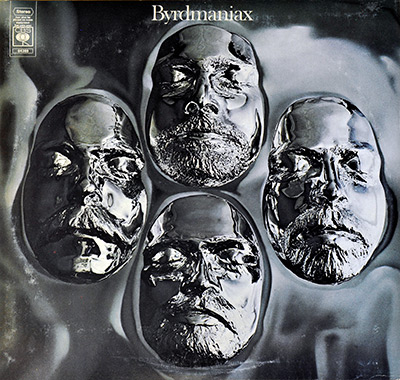
The album was recorded with a different lineup than the band's classic era, and it was largely dismissed by critics upon its release. However, "Byrdmaniax" still features some noteworthy tracks, including "I Wanna Grow Up to Be a Politician" and "Glory, Glory."
Learn more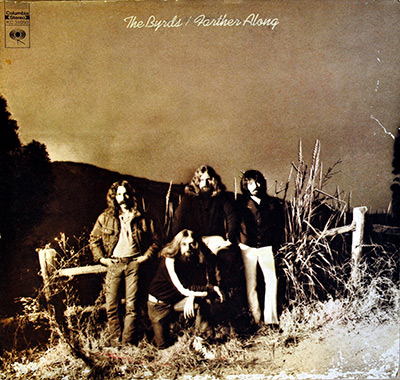
The core of "Farther Along" was recorded during an intense five-day session in London. The band, led by frontman Roger McGuinn with Chris Hillman, Skip Battin, and Gene Parsons, largely self-produced the album. The emphasis was on live, unadorned recordings that captured their raw energy.
Learn more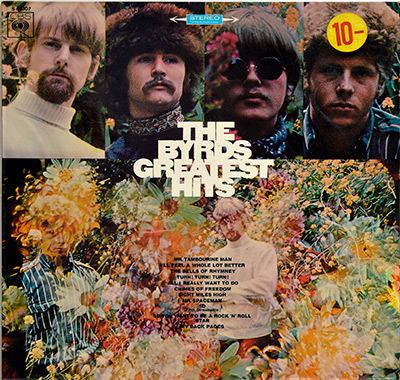
This is the first Dutch release of "Greatest Hits" by "The Byrds" and the record label has a solid Orange colour and the CBS "Walking Eye" Company Logo. Later issues of the Dutch release have an orange to yellow colour grading on the label.
Learn more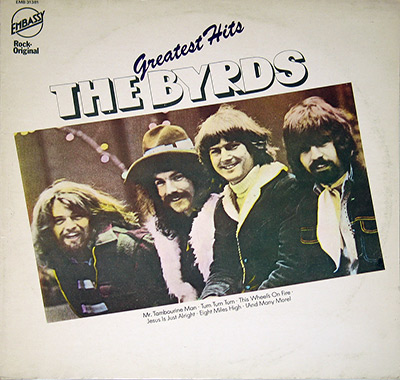
Embassy Records was a budget label famous for selling cover versions of popular hits exclusively through Woolworths stores. They offered cheaper alternatives to original singles, targeting young listeners with limited budgets. Embassy thrived in the 1950s and 60s, known for quick production and affordability
Learn more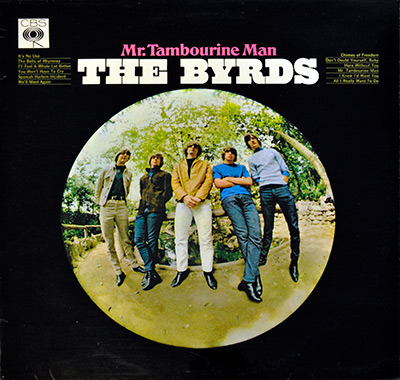
The album's opening track, "Mr Tambourine Man," is a Bob Dylan cover that the band made their own. The song features the band's signature vocal harmonies, jangly guitars, and the distinctive 12-string Rickenbacker guitar played by lead guitarist Roger McGuinn. The song's success helped establish the band
Learn more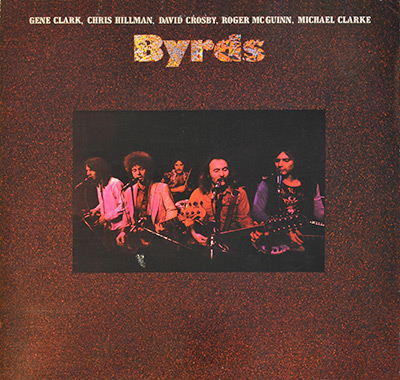
The reunion album aimed to revisit the sound that made The Byrds famous nearly a decade earlier: jangly guitars, tight harmonies, and a folk-country foundation. While some songs echoed the band's earlier work, there was also a sense of seasoned musicianship and a willingness to take subtle risks.
Learn more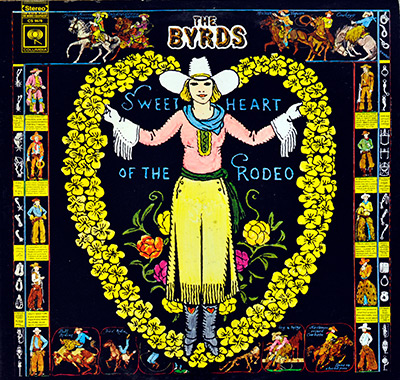
By the time The Byrds entered the studio to record "Sweetheart of the Rodeo," the band had weathered significant changes. Founding members David Crosby and Gene Clark had departed, leaving Roger McGuinn and Chris Hillman as the core members. New to the fold were Gram Parsons, a rising star with a passion
Learn more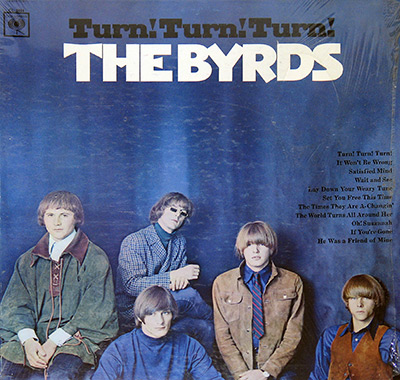
The Mono edition of the album is highly sought after by collectors and music enthusiasts. The Mono version of the album is different from the stereo version in that it has a more raw and authentic sound. The Mono edition has a single channel of audio, which gives it a more unified and coherent sound.
Learn more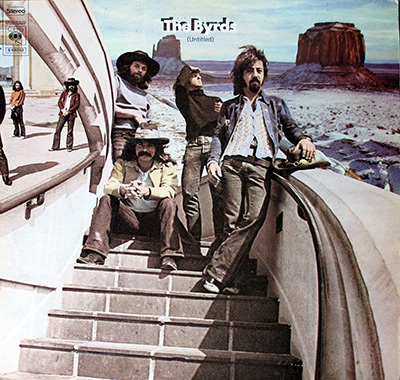
The Byrds' "Untitled" album was a double LP set that included both live recordings and studio tracks. The live recordings were taken from concerts that the band had performed at the Fillmore East in New York City and the Fillmore West in San Francisco. The studio tracks were recorded at Columbia Studios
Learn more